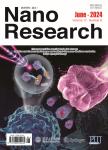Switchable C02 electroreduction via engineering active phases of Pd nanoparticles
Switchable C02 electroreduction via engineering active phases of Pd nanoparticles作者机构:State Key Laboratory of Catalysis CAS Center for Excellence in Nanoscience Dalian Institute of Chemical Physics Chinese Academy of Sciences Dalian 116023 China College of Chemical Engineering Zhejiang University of Technology Hangzhou 310032 China Canadian Light Source Inc. University of Saskatchewan 44 Innovation Boulevard Saskatoon Saskatchewan S7N 2V3 Canada Shanghai Key Laboratory of Molecular Catalysis and Innovative Materials Collaborative Innovation Center of Chemistry for Energy Materials Department of Chemistry Fudan University Shanghai 200433 China Shanghai Synchrotron Radiation Facility Shanghai lnstitute of Applied Physics Chinese Academy of Sciences Shanghai 201204 China University of Chinese Academy of Sciences Beijing 700039 China
出 版 物:《Nano Research》 (纳米研究(英文版))
年 卷 期:2017年第10卷第6期
页 面:2181-2191页
核心收录:
学科分类:0808[工学-电气工程] 0809[工学-电子科学与技术(可授工学、理学学位)] 07[理学] 0805[工学-材料科学与工程(可授工学、理学学位)] 0702[理学-物理学]
基 金:the Strategic Priority Research Program of the Chinese Academy of Sciences 国家自然科学基金 support from the National Basic Research Program of China
主 题:carbon-dioxide electroreduction Pd nanoparticles active phase selectivity fluctuation
摘 要:Active-phase engineering is regularly utilized to tune the selectivity of metal nanoparticles (NPs) in heterogeneous catalysis. However, the lack of understanding of the active phase in electrocatalysis has hampered the development of efficient catalysts for CO2 electroreduction. Herein, we report the systematic engineering of active phases of Pd NPs, which are exploited to select reaction pathways for CO2 electroreduction. In situ X-ray absorption spectroscopy, in situ attenuated total reflection-infrared spectroscopy, and density functional theory calculations suggest that the formation of a hydrogen-adsorbed Pd surface on a mixture of the α- and β-phases of a palladium-hydride core (α+β PdHx@PdHx) above -0.2 V (vs. a reversible hydrogen electrode) facilitates formate production via the HCOO intermediate, whereas the formation of a metallic Pd surface on the β-phase Pd hydride core (β PdHx@Pd) below -0.5 V promotes CO production via the COOH" intermediate. The main product, which is either formate or CO, can be selectively produced with high Faradaic efficiencies (〉90%) and mass activities in the potential window of 0.05 to -0.9 V with scalable application demonstration.



